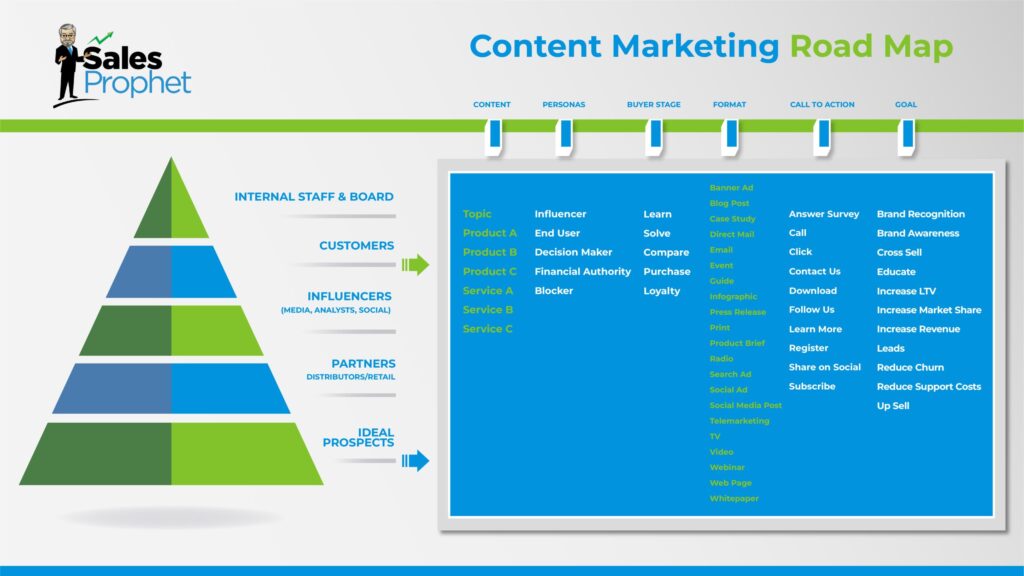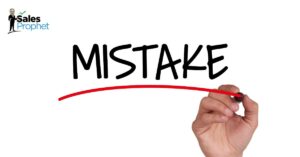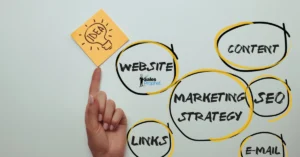Marketing agencies have always known that companies need a content marketing strategy to be effective in their lead generation efforts. However, if you are a b2b salesperson or sales consultant you might be asking yourself, “why do I need a content marketing strategy?” Some salespeople might even say, “just give me a lead and I can sell them anything.”
To be effective in your sales or marketing efforts you must understand your buyer personas typically involved in the buying process in order to be relevant. Relevancy is key to everything.
We covered the topic of how to develop buyer personas here. If you haven’t read that guide, I highly recommend you stop reading this guide and read how to develop a buyer person first. Then come back to this guide on how to develop a content marketing road map.
If you sell a considered purchase with an extended sales cycle, studies from Harvard Research suggest your target account can have as many as sixteen different people (Personas or Influencers) in charge of various aspects of the purchasing decision.
Gartner’s research recently reported there are usually six to ten decision-makers in any major purchase decision.
We are not suggesting you need to develop six to sixteen buyer personas in order to create an effective content marketing strategy. Realistically, you have at least four or five personas at the very least.
These personas include:
1. Researcher/Influencer
2. End User
3. Decision Maker
4. Financial Authority
5. Blocker
The idea is to have content that addresses the questions and challenges of each of these personas by buyer stage.
• Learn – “I think I have a problem.” The journey starts when someone realizes that something in the company isn’t working the way it should or could be.
• Solve – “How do I solve that problem?” They conduct research into possible solutions—one of which will hopefully be your brand.
• Compare – “Am I solving the problem the right way?” They look at your solution to the problem and compare it to your competitors’ solutions. Is one better than the other? Is one cheaper? Is the more expensive solution worth the extra money?
• Purchase – “Help me make a purchase decision.” This is the moment when your company and your product become their preference.
• Loyalty – “Show me you appreciate me as a customer.” This step is often overlooked. Many companies are so concerned with getting the customer to buy their product that they don’t consider how satisfied they are with the product once they’ve made the purchase. This can lead to buyer regret and high customer churn. It takes 10 times more effort and resources to acquire a new customer than it does to keep an existing customer. By putting a little bit more effort into customer loyalty, you can earn their business for life.
In almost every major purchase with an extended sales cycle, your prospects go through these buying stages above. They might not follow a linear path from top to bottom, but they will go through all of these stages at some point during the buying process.
We strongly urge you to complete a content assessment and determine what content you have or that can be repurposed for each persona and buying stage.
Researchers/Influencers – This may be two separate people or just one person. Their job is to research the right solutions that will address their company’s particular problem. They usually pick three of the top vendors they believe will address the problem and present those vendors to the rest of the buying committee. They will collect data on your product or service —and on your competitors’ products and services. They will need content that covers your capabilities, pricing, comparison charts, case studies etc.
Keep in mind that for smaller companies the researcher might also be the end user.
End-User – You will want content that answers all of the questions that user might be asking themselves.
For example: How difficult is this product or service to use? How long does it take to implement? What kind of support you will provide. What does training look like? How long does it take to learn? Will this solution be disruptive to our current processes? How is this solution better than what we are currently using today and why?
Decision Makers – You will want content about how your product will affect their team and overall success.
Your content needs to answer questions like: Will it make or team or company more efficient? Will this solution make us more effective? What are the benefits of this solution over their existing solution? What’s the ROI? What kind of reporting for you offer?
Financial Authority – You will want content that covers the actual terms and conditions or financial aspects of working with your company. Other questions your content needs to answer might include: What is the service level agreement? What are your escalation policies? What are your cancellation policies? Do they offer a money back guarantee?
Blocker – Blockers are people or personas that often disrupt the buying process or challenge certain aspects of the solution you are providing. A good example of this when selling sales automation solutions like Sales Prophet often time the CTO of a company becomes a blocker. You can’t blame him or her because their tasked with making sure they stop any outside threats to the data security. They are also in charge of stopping or blocking spam from entering the company’s firewalls and potentially infecting the computer system. To address this we need content that will address those concerns or risk losing the deal.
Ask the Right Question
As you can see from the personas listed above, each have their own unique perspectives, questions and concerns. This is why, it’s so important to create buyer personas for each of these people.
Start by asking each persona the right questions. Think of this exercise as a giant F&Q project.

The idea is to identify all the possible questions each persona will have at each stage of the buying process so you can address their concerns. There are a few ways to do this, but we prefer a phone call with your existing customers and asking them what issues they had at each stage. You can guess which questions prospects might have at each stage by putting yourself into the role if each persona, but its always better to hear directly from that persona. Some companies try using surveys to find these questions or concerns, but it’s been our experience that you uncover more information when speaking directly to your ideal personas.
Something to Consider
Often, companies develop robust buyer personas based on how the customer interacts with the product rather than how the customer buys and what content they consume during the buying process. Ask yourself, what frictions do I need to overcome to align with the customer’s needs?
Here are some sample questions you might want to ask your prospects to gain additional insight into their buying concerns:
What trends or regulations are affecting the way you do your job?
What’s the most challenging aspect of your job? – What can we help you with to make it easier?
What does your research process look like? – Where do you typically start? Do you assign a junior person or a senior person to the task?
What sources do you trust? – Who are your peers or influencers? Do you spend time on any online networks or media sites that may shape your views?
Who do you consult with when conducting research and making a buying decision? – Is it one individual, influencer, consultant, or review site?
What are the trigger events that put you into an active buying process? – Perhaps a new industry regulation has necessitated a new way of doing things. Maybe their existing manufacturing process is causing damage to their product. Maybe they’ve just outgrown their current solution.
What causes you to look for a new solution? Are you proactively looking for the latest and greatest solutions for your business, or are you reactively in the market because of a problem you’ve recently encountered?
What information is most helpful as you’re researching new solutions? Do you prefer guides, comparison charts, case studies, webinars?
Remaining Relevant
Let’s say you have done your homework and have created content for each stage of the buying process for each persona and you have identified what puts your ideal prospects into an active buying process. You might be asking yourself; how do I stay relevant? Fortunately, there are several resources that can provide you with a steady stream of topics and issues for your prospects industry.
Google Alerts – Set alerts for specific keywords in your industry. Google will then tell you whenever there’s new news or content pertaining to those keywords. These alerts can help you stay abreast of what’s going on in the industry and build content around it.
BuzzSumo – With an archive of billions of articles and trillions of social media posts, it lets you keep your finger on the pulse of your industry and provides you with insights into what the important people in your field are talking about.
Semrush – This service provides you with various tools to discover relevant keywords, improve SEO, research your competitors’ content strategies, and more.
Talkwalker – This tool uses AI algorithms to monitor social media and the internet, providing you with a range of content alerts.
AnswerThePublic – What are people searching for on Google? What questions are they asking? What topics are they interested in? AnswerThePublic monitors the autocomplete data for popular searches to determine what types of questions are being asked by any given person or group and provides you with relevant customer insights.
Marketing Your Content
By now you’ve probably got a good idea of what your prospects and personas are looking for during the buying process when purchasing your product or service.
But let’s face it, even after creating all this content there is no guarantee Google will find and index your content, so it ranks well on search engines. In fact, waiting on Google to promote your content is like putting your destiny in the hands of Google which is madness.
For this reason, we recommend formatting your content into helpful guides, whitepapers, research and case studies.
Your next question might be, “How do I get this content in the hands of my ideal prospects and build demand for our products and services?” Sure, you can post it on your website and hope it gets ranked by search engines. Perhaps promote this content on social media channels but who are we fooling. It will take months of posting this content to drive any significant traffic, let alone leads. Not to mention, we have no control over who sees this content when simply posting it on social channels.
That’s why we are huge fans of mass email marketing.
This is why Sales Prophet integrated a massive database of over 86 million b2b contact records. This gives our users the ability to create lists of their ideal prospects and send them their helpful content. Keyword is helpful content. No one minds receiving an unsolicited email as long as its helpful and relevant. That’s why its so important to build ou your content marketing road map. Relevancy is key to your success.
Sales Prophet added an easy to use drag and drop email builder for creating branded HTML emails so you can send large campaigns directly to your target audience while also building your brand as helpful thought leaders in your industry.
We also gave Sales Prophet users more control over how their mass emails are sent for better deliverability. You can send one email at a time over x number of seconds, hours or days in a week. Nee more volume of email? No problem, simply connect to a third-party SMTP provider of your choice. We have direct integrations with SendGrid, SparkPost or Mailgun which will allow you to send higher volumes of email faster.
Just make sure to ask yourself what kind of guide or research can I share that would be seen as helpful and relevant?
This content is less about your company, products, and services and more about the industry as a whole and the problems your solutions solve.
Here are some examples we created for a couple of clients.
northAmerican® Van Lines is a large moving company with a lot of competition. They hired us to support their corporate division’s marketing efforts. This division supports corporate HR and Mobility executives by providing employee moving and relocation services. If you are a large company or a growing company, chances are you will have to hire and relocate employees to support your company’s growth efforts.
So we decided to launch a research project and ask their target audience questions about their relocation programs i.e., policy types, program goals, challenges, impact of covid19, number of relocations to manage in a year, expected volumes for the current year and also asked them what puts these executives in an active buying process. All of the data was broken down by job titles, levels, departments, company size and more.
When then broke up the content into three categories i.e., blog posts, guides, and research studies. Then we promoted the high value content (Guides and Research) using mass email targeting over 125,000 ideal prospects at companies with more than 200 employees in key industries.
The guides were written and designed to provide helpful content to a single topic. No sales jargon, just helpful content.
We sent out 10k emails a day from Tuesday to Friday which took a little over 3 weeks to send. Past experiences told us that if we keep the volume under 10k a day we experienced better deliverability. We also used two different email accounts, so technically we sent out 5k emails day over two email accounts using SparkPost and Mailgun (SMTP Providers).
Our unique open rate was 24% with a unique click through rate of 52.6%. we captured over 200 form fills or qualified leads. The best part is that piece of content still gets downloads and leads today (10 months later)
Note: This is just one campaign. We have sent hundreds of these campaigns over the years.
Mass Email Results?
We sent close to 2 million emails over the last year and generated thousands of clicks, downloads and leads with only 3 spam complaints.
It would be nearly impossible to get the same results using seo tactics and it would cost hundreds of thousands of dollars in paid media, especially a pay per click campaign where the client is spending over $25 a click.
That’s why we are big believers in mass email. However, you must be committed to sending helpful thought leadership content or risk high number of spam complaints, and potential damage to your email reputation, brand and deliverability.
Bottom line no one minds receiving an unsolicited email if it’s helpful or relevant content and we can prove it.
Here are some ideas you can use to create your own guide or research study.
Satisfaction surveys are great for collecting information not only about your product or service but your competitors as well. One of the most successful pieces of content we ever created for northAmerican is their Relocation and Moving Satisfaction Study. We created this study in 2020 (Two years ago) and still get downloads and leads from that piece of content.
Another important issue is the environment. What’s your company’s carbon footprint? How much waste do you produce? Do your products biodegrade? Are they easy to recycle? A study on your company’s environmental impact can be eye-opening—and open the door to easing the minds of a lot of your potential customers who are concerned about climate change.
Years ago, I did a benchmark study on the average cost per lead companies were paying for sales leads. We broke the cost per lead data down by industry and marketing channel. That research is still be used today and its nearly 6 years old!
These are just a few examples. Collecting this sort of data can be invaluable to your company and provide a cornucopia of insight into your customer base and how best to reach them.

Marketing campaigns tend to ebb and flow. Some are successes, others are failures. It can be a bit of a roller coaster ride. However, when you develop a content marketing strategy and road map, you can help level your results in a more predictable manner.
By understanding what’s important to your customers and where they’re coming from, and creating content around that, you can make campaigns that are steadier and more reliable.
Content Marketing Isn’t Just for Prospects!
Now let’s talk about your content marketing efforts for your employees, existing customers, resellers, and industry influencers. Here are the important destinations on the road to engagement.
Internal. At the very top of your strategic road map is your internal communications. Everyone in your company, from the janitor to the CEO needs to know your value proposition—essentially the elevator pitch. The idea is if you can’t internalize your message, you can’t externalize your message.
Existing Customers. Who are they and what are they concerned about? What content do you give them to make them feel good about their decision to pick you from your competitors? How are you showing these customers you appreciate their business?
Media Influencers. Who are the movers and shakers in your industry? Who are the people everyone listens to? Media executives, industry analysts, social pundits, etc. How can you communicate with these people and engage with them? If you can get their attention, they can help you get the attention of a lot more people.
Resellers and Distributors. If you have third party resellers, how are you supporting them with their sales efforts? What insights can you give them into your value proposition? Is there any training you can provide them, or a guide that will help them boost their sales of your products and services?
Prospects. We covered how to create content for your prospects above.
But there’s more! If you go through this exercise, you will also wind up with a piece of content that will support your sales enablement efforts. Your salespeople will better understand their prospects and this content will be at their disposal during the sales process. Win-Win!

You will notice the two arrows next to customers and prospects. The point is to identify each persona and take them on a journey from Learn, Solve, Compare, Purchase and Loyalty. What do you want to say to each persona, what, why and don’t forget to tell your prospect or customer what you want them to do next (Call to Action).
Then pick the format you want to use to share this content and assign a goal for each piece of content. Goals can range from increasing your brand awareness to driving traffic, leads, increasing the lifetime value (LTV), cross sell / up sell, reduce customer churn or reduce cost per customer acquisition as a few goals.
You will be hard pressed to find a scenario where this model doesn’t work.
Through it all, don’t forget: It starts with being relevant. That’s the only way you can really reach anyone with any effectiveness. You can bombard them with e-mails, but if it’s not something they’re interested in or relevant, they will simply hit the delete button or worse complain that you are a spammer.
But if you can provide your prospects with the content that interests them, that really speaks to something they find important, then they’ll stop to look at it. They’ll engage with your brand and begin their journey that hopefully ends with them as a loyal customer—as long as you can stay relevant to them. It all starts with relevance. If you can tap into that, then your content will soar.




